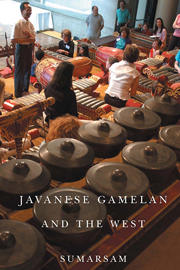Book contents
- Frontmatter
- Contents
- List of Illustrations
- Preface
- Acknowledgments
- Note on Orthography
- Introduction
- Part One Hybridity in Javanese Performing Arts
- Part Two Gamelan as Intercultural Object
- 4 Deterritorializing and Appropriating Gamelan
- 5 Cross-Cultural Perspectives on Gamelan Theory: Metaphorical Readings of Gamelan
- Conclusion
- Notes
- Glossary
- Selected Discography
- Bibliography
- Index
5 - Cross-Cultural Perspectives on Gamelan Theory: Metaphorical Readings of Gamelan
from Part Two - Gamelan as Intercultural Object
Published online by Cambridge University Press: 05 September 2013
- Frontmatter
- Contents
- List of Illustrations
- Preface
- Acknowledgments
- Note on Orthography
- Introduction
- Part One Hybridity in Javanese Performing Arts
- Part Two Gamelan as Intercultural Object
- 4 Deterritorializing and Appropriating Gamelan
- 5 Cross-Cultural Perspectives on Gamelan Theory: Metaphorical Readings of Gamelan
- Conclusion
- Notes
- Glossary
- Selected Discography
- Bibliography
- Index
Summary
In the 1960s, ethnomusicology was commonly defined as the study of music in culture, and Alan Merriam's anthropological approach became the defining practice of the field. Mantle Hood, however, emphasized the musicological side of ethnomusicology. This anthropological-musicological divide is often described as the “Merriam-Hood split.” In subsequent studies, a number of ethnomusicologists attempted to find the points of intersection, causation, or homologies between Merriam's three analytical levels—concept, behavior, and sound.
The works of Steven Feld, Marina Roseman, and Judith Becker, to mention just a few, offer a new trajectory in the search for these connections, bridging the anthropological-musicological split and moving toward the unification of musical analysis and socio-ethnography. This change of emphasis happened when the definition of ethnomusicology as “the study of music as culture” gained momentum. Recently, Ingrid Monson has proposed a more encompassing definition, namely “the interdisciplinary study of music as cultural practice.” Monson also feels that it is necessary to distinguish ethnomusicology from other fields, including cultural studies. It is important for her to include “interdisciplinary study” in her definition of ethnomusicology “in order to emphasize a practice-based anthropological conception of culture.” This definition resonates with the present study, the aim of which is a discourse that strikes a balance between musical processes and socio-ethnography. Before embarking this topic, a brief background of the development of gamelan theory is in order.
- Type
- Chapter
- Information
- Javanese Gamelan and the West , pp. 115 - 138Publisher: Boydell & BrewerPrint publication year: 2013

